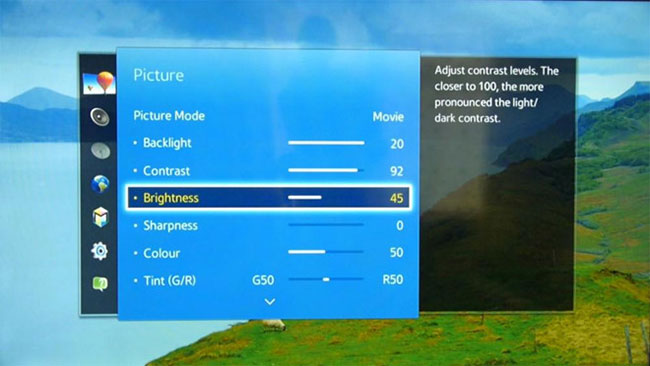Harmful myths when adjusting the TV definition
Sharpening is the most integrated feature on today's newer TVs. However, there is a fact that when you adjust the high-definition television not only does not increase the detail of the image but also can reduce the image quality.
- Learn the current popular resolution on TV
- The reason why TV images in supermarkets are often better than at home
- 5 steps to improve TV image quality
Increasing sharpness merely increases the edge edge brightness
Many people mistakenly think that increasing the sharpness can make the screen sharper and have a habit of maximizing sharpness on the TV. But the fact is that when you increase the sharpness, it merely increases the edge of the image, it gives a "fake" feel when viewed.
On most newer TVs today, when you increase the sharpness, the edges will be brightened with a thin or bright coating around. For example, in the following example, it can be seen that buildings are covered with a bright border after the user increases the sharpness index.

Although the image is clearer in some ways, however, if the image is not enhanced, it seems more 'soft'. And if you notice that you see bright edges that obscure the surrounding details, it even makes other parts of the image noise (noise).

Other tweaks
Based on each type and model of TV or projector, there will be different image sharpening adjustments. As on Sony TVs with Reality Creation function. But, the advice for you is to turn these features off, let the real image be as close to the source as possible. In case you still want to experience the test, then you set up no problem, if you increase the sharpness to match your eyes, the better, right.
Source
Normally, increasing the edge edge will be in the source, popular on previous DVD types, you will not do anything more if it is located in this position. But if you want to try different tweaks, work on multiple sources to feel the difference, you can change a higher quality or lower movie or video.

How to adjust the TV definition accordingly?
For some TV models, especially older TVs, turn on the default feature and there is no way to adjust effectively. Even if you reduce the sharpness to zero, the effect remains.
As for Sony's recent models, you can adjust it to zero to make the image softer, or adjust it below 50 on some LG TVs.
For other TVs, you can fine-tune the TV's sharpness to one or two levels from zero, or to half up on the focus bar.
See more:
- Instructions on how to increase processing speed for Smart TV
- What is the best color correction for the screen?
- TV control applications on the phone
You should read it
- What's special about 8K TV? The hottest 8K TV series today
- Samsung launched the biggest 8K TV on the planet, 98 inches, yet any television content reached a great definition for projection
- Instructions to choose to buy television suitable for families with older people
- So and should not care what technologies on TV
- How to know if the TV is connected to the phone?
- HP released a new multimedia notebook
- MyTV Multiscreen - the perfect multi-screen feature on the rise of technology television
- Techniques of choosing to buy television sets .... NET
May be interested
- 8 dangerous toys can harm children and make the right choice
 please refer to the list of 8 dangerous toys that can be harmful to children and how to choose the correct article below!
please refer to the list of 8 dangerous toys that can be harmful to children and how to choose the correct article below! - What is the API?
 api stands for application programming interface, an intermediary software that allows two applications to talk to each other. every time you use an app like facebook, send an instant message or check the weather on your phone, you are using the api.
api stands for application programming interface, an intermediary software that allows two applications to talk to each other. every time you use an app like facebook, send an instant message or check the weather on your phone, you are using the api. - Are green light filtering applications really effective?
 there is an unquestionable fact that looking at the screen for a long time (maybe a phone, computer, tv) before going to bed will bring a lot of harm to the eyes and the quality of sleep.
there is an unquestionable fact that looking at the screen for a long time (maybe a phone, computer, tv) before going to bed will bring a lot of harm to the eyes and the quality of sleep. - Ways of blending 80s image colors in Photoshop
 color blend in photoshop greatly supports the image, creating a unique color effect for the image.
color blend in photoshop greatly supports the image, creating a unique color effect for the image. - 9 bad habits should be removed immediately if you don't want to get in trouble
 having good habits and harmful habits, you need to consider to eliminate immediately if you don't want to be in trouble. please join us to refer to 9 bad habits to eliminate immediately to make life better in this article!
having good habits and harmful habits, you need to consider to eliminate immediately if you don't want to be in trouble. please join us to refer to 9 bad habits to eliminate immediately to make life better in this article! - How to download Realtek High Definition Audio driver for Windows 11
 are you having audio problems on your windows pc? if so, it might be time to update your realtek high definition audio driver.
are you having audio problems on your windows pc? if so, it might be time to update your realtek high definition audio driver. - How to Tell if You're Watching TV in HD
 high definition television (hdtv) is a digital form of television capable of supporting a high number of pixels and delivering high-resolution, high-quality images on a monitor or display. standard definition (sd), however, has a lower...
high definition television (hdtv) is a digital form of television capable of supporting a high number of pixels and delivering high-resolution, high-quality images on a monitor or display. standard definition (sd), however, has a lower... - 5 netbooks have high definition screens
 netbook configurations on the market today are usually similar, so manufacturers are looking to reduce prices or increase battery life and screen resolution to compete.
netbook configurations on the market today are usually similar, so manufacturers are looking to reduce prices or increase battery life and screen resolution to compete. - 6 steps to plan harmful software counter-attacks
 as a security administrator, we strive to be a pioneer in this area - apply pieces and updates, penetration testing and set-up policies. unfortunately, sometimes the defense is on
as a security administrator, we strive to be a pioneer in this area - apply pieces and updates, penetration testing and set-up policies. unfortunately, sometimes the defense is on - Air compressors - Definition and Uses
 air compressors are one of the most widely used tools in everyday life. air compressors function to increase the pressure of the gas, suitable for industrial use such as printing, dirt cleaning, car drying ...
air compressors are one of the most widely used tools in everyday life. air compressors function to increase the pressure of the gas, suitable for industrial use such as printing, dirt cleaning, car drying ...










 What is the virtual assistant on TV, which TV streams are integrated virtual assistants?
What is the virtual assistant on TV, which TV streams are integrated virtual assistants? Instructions for checking LG TV warranty information
Instructions for checking LG TV warranty information What's special about 8K TV? The hottest 8K TV series today
What's special about 8K TV? The hottest 8K TV series today The television screen blinks continuously, cause and remedy
The television screen blinks continuously, cause and remedy Why must I set the correct date and time for Smart TV?
Why must I set the correct date and time for Smart TV? What to do when the TV screen is abnormally hot?
What to do when the TV screen is abnormally hot?